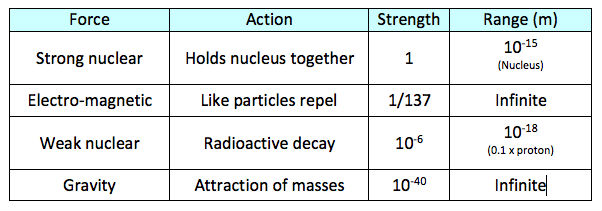-
WHAT IS NASA PHYSICS?
-
MODULES
-
Forces and Motion
-
Conservation of Momentum & Energy
-
Temperature and Heat
-
Fluids
-
Optics
-
Electromagnetic Spectrum
-
Modern Physics
-
Anticipation Guide 7
-
Intro to Modern Physics
-
Blackbody Radiation
-
The Ultraviolet Catastrophe
-
The Photoelectric Effect
-
Bohr's Atom
-
Spectra
-
Radioactive Decay
-
Special Relativity (SR)
-
Simultaneity
-
Distance and Time
-
General Relativity
-
May the Forces be with You
-
Modern Physics Notebook
-
Assessment Problems 7
-
-
Useful Things
-
-
SITE MAP
Modern Physics
-
Anticipation Guide
-
Intro to Modern Physics
-
Blackbody Radiation
-
The Ultraviolet Catastrophe
-
The Photoelectric Effect
-
Bohr's Atom
-
Spectra
-
Radioactive Decay
-
Special Relativity (SR)
-
Simultaneity
-
Distance and Time
-
General Relativity
-
May the Forces be with You
-
Notebook
-
Assessment Problems
May the Forces be with You
Physics deals with forces and all the consequences of them.
In physics there are four fundamental forces that lead to everything else that exists. From strongest to weakest these forces are the
• strong nuclear force,
• electro-magnetic force,
• weak nuclear force and
• gravity.
All four are required for the universe to exist, for atoms to exist, for life to exist, and for Earth to orbit the Sun.
Gravity is the force that is most familiar to us. We understand that gravity causes things to fall, to be pulled toward the center of Earth. If your iPhone has a cracked faceplate, gravity probably was involved. Scientists can write equations that perfectly predict the effects of gravity – that is why we can program spacecraft to fly to Mars – but no one actually understands exactly what gravity is or how it works. Einstein’s General Theory of Relativity says gravity isn’t a force but just a bend in space-time. Gravity is associated with mass. Anything with mass – which is everything in the universe except for some subatomic particles such as light – attracts other massive things to it. But the force of gravity is very, very weak, otherwise a massive object such as a building would pull nearby things to it – we know from personal experience that that doesn’t happen. But with a very precise instrument to measure gravity we can determine that a mountain does exert a small gravitational pull on things near it.
Gravity works over infinite distances, but it weakens rapidly with distance – otherwise we might all be pulled into the Sun, the nearest hugely massive body. But even though weak, the Sun’s gravity holds the planets in orbits around it, otherwise Earth and the other planets would go careening off through space.
The force of gravity is too weak to hold an atom together. An atom has a nucleus, which has a positive charge surrounded by a swarm of negatively charged electrons. As you remember from grade school, opposite charges attract and similar charges repel - this so-called electromagnetic force (opposites attracting) is what allows atoms to exist. The EM force is also why electricity flows through a wire, as negatively charged electrons flow towards a positive terminal.
Within the nucleus of an atom there are two more forces at work. A nucleus contains just two main types of particles, neutrons and protons. Neutrons, as their name suggests, are neutral and have no electric charge, but protons are positively charged. So the protons packed together in the nucleus try to push apart from each other (from the EM force with similar charges repelling). The strong nuclear force working within the nucleus is stronger than the EM force and holds the protons together. Without the strong nuclear force atoms couldn’t exist, and neither would you.
The weak nuclear force helps some nuclear processes – like radioactivity – to occur that otherwise would not. It is critical for the formation of deuterium in the Sun, which is necessary for the Sun to exist, and is crucial for the creation of heavy elements, which we are mostly made of.
The four fundamental forces are all necessary for the universe as we know it to exist, and they are vastly different in their characteristics:

From: Hyperphysics
In classical physics courses only the effects of gravity and EM are studied in detail. But being aware of the four forces makes you, if not a master of the universe, aware of the forces that control it.
© 2013 by Wheeling Jesuit University/Center for Educational Technologies®. 316 Washington Ave., Wheeling, WV 26003-6243. All rights reserved. Privacy Policy and Terms of Use.

